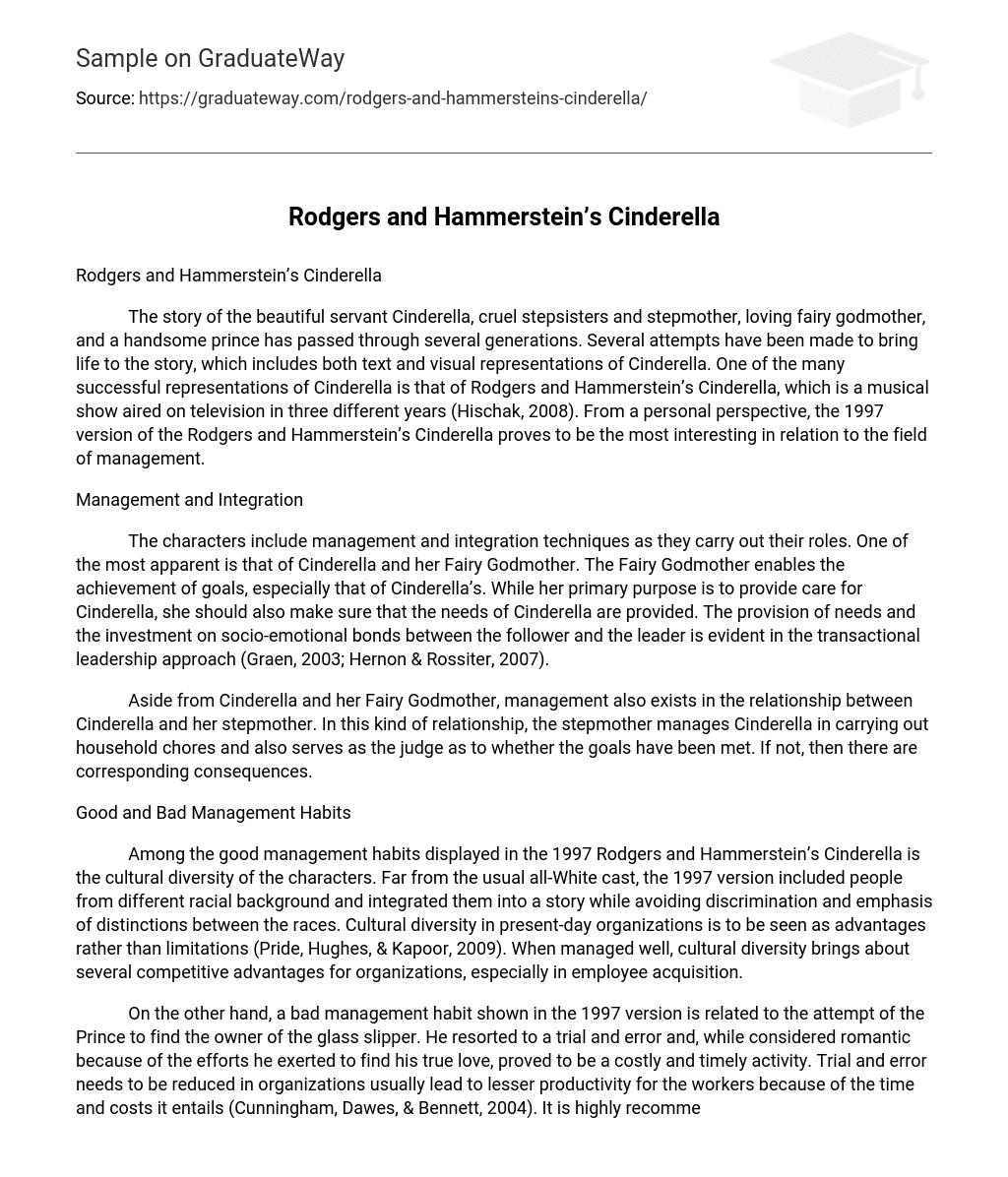The story of the beautiful servant Cinderella, cruel stepsisters and stepmother, loving fairy godmother, and a handsome prince has passed through several generations. Several attempts have been made to bring life to the story, which includes both text and visual representations of Cinderella. One of the many successful representations of Cinderella is that of Rodgers and Hammerstein’s Cinderella, which is a musical show aired on television in three different years (Hischak, 2008). From a personal perspective, the 1997 version of the Rodgers and Hammerstein’s Cinderella proves to be the most interesting in relation to the field of management.
Management and Integration
The characters include management and integration techniques as they carry out their roles. One of the most apparent is that of Cinderella and her Fairy Godmother. The Fairy Godmother enables the achievement of goals, especially that of Cinderella’s. While her primary purpose is to provide care for Cinderella, she should also make sure that the needs of Cinderella are provided. The provision of needs and the investment on socio-emotional bonds between the follower and the leader is evident in the transactional leadership approach (Graen, 2003; Hernon & Rossiter, 2007).
Aside from Cinderella and her Fairy Godmother, management also exists in the relationship between Cinderella and her stepmother. In this kind of relationship, the stepmother manages Cinderella in carrying out household chores and also serves as the judge as to whether the goals have been met. If not, then there are corresponding consequences.
Good and Bad Management Habits
Among the good management habits displayed in the 1997 Rodgers and Hammerstein’s Cinderella is the cultural diversity of the characters. Far from the usual all-White cast, the 1997 version included people from different racial background and integrated them into a story while avoiding discrimination and emphasis of distinctions between the races. Cultural diversity in present-day organizations is to be seen as advantages rather than limitations (Pride, Hughes, & Kapoor, 2009). When managed well, cultural diversity brings about several competitive advantages for organizations, especially in employee acquisition.
On the other hand, a bad management habit shown in the 1997 version is related to the attempt of the Prince to find the owner of the glass slipper. He resorted to a trial and error and, while considered romantic because of the efforts he exerted to find his true love, proved to be a costly and timely activity. Trial and error needs to be reduced in organizations usually lead to lesser productivity for the workers because of the time and costs it entails (Cunningham, Dawes, & Bennett, 2004). It is highly recommended for organizations to use simulations or scientific methods of inquiry in order to lead to a more precise and less time-consuming strategies.
The creativity of the people in the movie were suppressed, to a certain extent, because they have to adhere to the original elements of the story’s structure. Aside from the characters, the story maintained the flow of events in the story and the emotions expected from them. Likewise, integration of cultural experiences from the actors and actresses remained unutilized.
References
Cunningham, I., Dawes, G., & Bennett, B. (2004). The handbook of work based learning. Hants, England: Gower Publishing Limited.
Graen, G. (2003). Dealing with diversity. Westport, CT: Information Publishing Age.
Hernon, P. & Rossiter, N. (2007). Making a difference: Leadership and academic libraries. Westport, CT: Libraries Unlimited.
Hischak, T. (2008). The Oxford companion to the American musical: Theatre, film, and television. New York, NY: Oxford University Press.
Pride, W., Hughes, R., & Kapoor, J. (2008). Business. Mason, OH: South-Western Cengage Learning.





